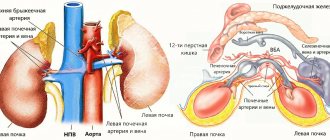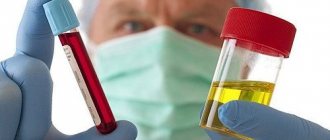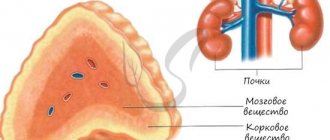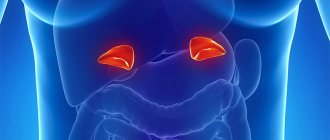These hormonal “comrades” are easy to confuse.
Both were originally discovered in the adrenal glands. They have similar names, even if you use their “middle” names: epinephrine and norepinephrine. The chemical formulas are similar. The starting material for synthesis is one - the amino acid tyrosine. Moreover, in the chain of synthesis of these hormones from tyrosine, norepinephrine (NA) is the precursor of adrenaline. In the chemical structure, norepinephrine and adrenaline differ in that NA is characterized by the absence of a methyl group at the nitrogen atom of the amino group of the side chain. And the “work” of these compounds in the body is similar: physiological support for the stress response - both of them are associated with arousal. But there are quite a lot of differences between them. And this is not surprising. Nature is a very economical “mistress” and will not keep two substances for one job. (But hanging several tasks on one hormone is just her style).
Norepinephrine and adrenaline: what is the difference
Hormone and neurotransmitter
Although epinephrine and norepinephrine act as both hormones and neurotransmitters in the body, adrenaline plays more of a hormone role. Norepinephrine is primarily a neurotransmitter.
Hormone
A hormone is a substance that is released into the blood by specialized cells. Often they are collected in a gland. Hormones travel through the bloodstream throughout the body and affect many tissues and organs. Moreover, their effect is long-lasting – minutes and hours.
Neurotransmitter
The neurotransmitter is produced in the axon (the outgrowth of the neuron). This process forms contact with the target cell in which mediators work: another neuron, a muscle cell, a gland cell. The action of the mediator is strictly selective - only on this target cell. The action is very short - no more than a few seconds.
The contact between a neuron's axon and another cell is called a synapse. A synapse is triggered when an electrical impulse arrives along the axon, which represents a signal about a sensory stimulus: an emotion, pain, a decision made by the brain. Released from the end of the axon, the mediator acts on sensitive proteins located on the surface of the target cell: receptors. For norepinephrine, these adrenergic system receptors are divided into two types: alpha and beta. They differ either in the speed of operation or in the nature of the effect that appears on the next cell: excitation or inhibition.
The action of norepinephrine is associated with a predominant effect on α-adrenergic receptors.
Norepinephrine and adrenaline: differences in the manifestation of the effect
The Great Medical Encyclopedia reports that physiologically the effect of norepinephrine is very similar to the effect of stimulation of the adrenergic system (i.e., the effect of adrenaline). At the same time, there is, as they say, a “fat BUT ”:
For example, the following situations cause the release of predominantly norepinephrine:
- Aggressive, active emotions,
- compression of the carotid arteries.
Read more about norepinephrine in “Dynamic norepinephrine.”
The predominant release of adrenaline occurs:
- with hypoglycemia,
- in response to pain
- with irritation of the sciatic nerve, injury and other factors that cause a metabolic reaction.
Norepinephrine and adrenaline: differences in action on the body
Norepinephrine primarily affects the cardiovascular system. The release of NA occurs when there is a need for changes in hemodynamics: in response to a change in posture, during physical activity, during bleeding. But at the same time, the stimulating effect of norepinephrine on heart contractions is weaker than that of adrenaline.
NA differs from adrenaline by a much more pronounced vasoconstrictor effect (norepinephrine is a strong vasoconstrictor).
Norepinephrine has a stronger pressor effect.
It causes an increase in both systolic and diastolic blood pressure, which can reflexively lead to severe bradycardia.
The effect of norepinephrine on the smooth muscles of the bronchi and intestines is less. Epinephrine is a more potent smooth muscle inhibitor than HA.
Norepinephrine increases the need for oxygen in the myocardium and other tissues to a lesser extent.
The effect of norepinephrine on metabolism is also weaker than that of adrenaline: there is no pronounced hyperglycemic, lipolytic and general catabolic effect.
What is the difference between adrenaline and norepinephrine?
Adrenaline and its precursor, norepinephrine , are adrenal medulla hormones and neurotransmitters. The actions of hormones are unidirectional. Both serve to mobilize the body during times of stress. The difference is in the degree, or quality, of stress.
How it works:
a danger signal is received, the hypothalamus sends a signal to the pituitary gland, which sends a signal to the adrenal glands, and they release hormones into the blood. Without neuromodulators, the body cannot adapt sharply and quickly. Adrenaline (and norepinephrine in the same way, but to a slightly lesser extent) works like this: the vessels of the internal organs (in particular the digestive tract) narrow, and the vessels feeding the muscles and bronchi dilate. That is, the body almost instantly becomes ready to quickly run away from danger or actively fight for life: the muscles and lungs receive maximum blood and metabolic processes accelerate. Digestion will have to wait, there is no time to digest breakfast - we must, in principle, retain the ability to be alive to digest the next lunch.
Norepinephrine is called the “stability” hormone. Or the “wakefulness” hormone. Adrenaline is the “anxiety” hormone. The names were received for the cause.
Example:
the person slept or lay down to rest for half an hour. The heart rate has slowed down, the body is relaxed, the muscles are at rest, thoughts flow slowly, there is silence and beauty all around. If a person remembers that he still has things to do and needs to do them, he calmly gets up to get to work - norepinephrine begins to be released. It simulates muscle activity, the heart muscle and encourages action. Yes, the state of rest has ended and the state of activity has begun. Yes, all the above actions to redirect blood flow through the vessels take place. There is only one thing missing: mad rush.
If the same person, resting on the sofa, suddenly heard a shot or saw that a Huge Wild and Hungry Beast was rushing towards him (or the boss called and began immediately calling for him to come to work, simultaneously calling heaven’s punishment on the head of a careless worker), then adrenaline is instantly released. And the difference from norepinephrine is that the heart rate (heart rate) begins to go off scale, breathing quickens, metabolic processes rush at a terrible speed, glucose and oxygen are delivered to the muscles and bronchi in higher than normal volumes and the person is instantly ready not just for physical activity, but to impressive and phenomenal physical activity. Adrenaline is always produced in such a “fight or flight” situation, thanks to it we survived in those harsh times when there was nothing to rely on except fast legs and strong muscles.
Functions and effects of norepinephrine
The hormone is responsible for various functions:
- accelerates the rate of heart contraction;
- due to norepinephrine, the pupils dilate and contract;
- has a meaning in the "flight or fight" function;
- increases glucose levels due to energy reserves;
- increases blood circulation in muscle tissue;
- increases the flow of oxygen to the brain, causing faster reactions.
Norepinephrine influences attention and regulates the sleep-wake cycle. This hormone regulates sexual behavior.
References
- Clinical guidelines “Neuroendocrine tumors”, approved. Ministry of Health of the Russian Federation, 2021. - 52 p.
- Mokhort, T.V., Veselevich, E.I., Mokhort, E.G. Pheochromocytoma: modern approaches to diagnosis and treatment. — International reviews: clinical practice and health, 2021. — No. 1(19). — P.4-23.
- Verly, I., Leen, R., Meinsma, J. et al. Catecholamine excretion profiles identify clinical subgroups of neuroblastoma patients. — European journal of cancer, 2021. — Vol. 111. - P. 21-29.
What it is? Basic information about this substance
It is very important to understand what norepinephrine is. It belongs to the group of catecholamines - active compounds formed from amino acids. In the human body, this substance performs a large number of functions - it is a mediator of nervous reactions, maintains homeostasis of the body, and ensures the normal physiological activity of all its structures. Even when studying this compound, medical scientists called it the “rage hormone” or “predator hormone.” Also identical to the concept of norepinephrine is its lesser-known term – norepinephrine.
Research on the adrenal glands and their hormones began at the end of the 19th century. The first to be isolated was adrenaline, or as it was then called - epinephrine. A little later, norepinephrine was discovered. Then scientists began to study the synthesis of these compounds, their effect on the body, after which the substances gradually began to be used in medicine. The discovery of these hormones (catecholamines) belongs to Henry Dale, an English neurobiologist and pharmacologist. The description and study of the mechanism of action of norepinephrine and adrenaline brought the Englishman the Nobel Prize in 1936.
Norepinephrine is produced by the adrenal glands, glands located at the very top of the kidneys. The secretion of this compound occurs during times of stress or shock. In such a situation, increased synthesis of norepinephrine gives a person a feeling of readiness to perform any task and confidence in their own abilities. After the production of such an active substance, many people have new brilliant ideas. At the same time, blood flow to the brain significantly increases, and even wrinkles on the face are smoothed out! The action of norepinephrine helps a person to easily cope with accumulated tasks and find a way out of a difficult situation.
This catecholamine is also known as the “happiness hormone” - it has a neutralizing effect on adrenaline (the so-called “fear hormone”). Under the influence of norepinephrine, the body relaxes and quickly gets rid of the negative effects of stress overexertion. Important physiological processes are normalized.
Why is the level of catecholamines in plasma determined?
Determination of the level of catecholamines in the blood is carried out in conjunction with other studies to identify the cause of a sharp increase in blood pressure, to diagnose tumors that produce excess catecholamines - pheochromocytomas, paragangliomas, neuroblastomas. Determining the level of catecholamines in the blood can give false results - both false positive and false negative, therefore tests for determining catecholamine metabolites in daily urine and excretion of fractionated catecholamines in urine are considered more indicative as screening (the first stage of diagnosis). However, blood catecholamine levels may be a more revealing test in patients with kidney disease. Also, the level of catecholamines in the blood and the ratio of their fractions can help in determining the type and location of the tumor.
This test is used in an in-depth study of the condition of patients with heart failure, mental disorders, migraines, diabetes, obesity, bronchial asthma, etc.
How does this catecholamine work?
Norepinephrine is a substance that is responsible for several important functions at once. And it’s not for nothing that it is also called the “hormone of anger,” because this mediator plays a decisive role in the negative effects of stress. Any psychological stress causes an increase in the production of this active substance, while all the forces of the body are mobilized to combat the negative factor affecting it. In this case, people have a corresponding body reaction:
- pupils narrow or dilate;
- blood circulation in the brain increases;
- tachycardia is observed;
- Glucose, which is necessary to provide the body with energy in a difficult situation, enters the blood from the fat depot;
- blood supply to the muscles of the whole body increases, for faster movement if necessary.
Norepinephrine - this hormone starts the work of the heart muscle, speeds up the rhythm of its contractions. If the level of this substance is elevated, the patient's pulse rate increases. It is for this reason that this compound is actively used by emergency doctors when providing emergency care to a patient. In case of cardiac arrest, he is immediately injected with a solution of Norepinephrine. After this, the heart muscle begins to work again and the patient has a pulse. This is how norepinephrine saves lives.
The hormone has a motivating effect. In case of imminent danger, it begins to stand out. At the same time, the motor function of the body significantly accelerates, confidence and readiness for the upcoming fight increases. The need for such a reflex is due to the protective reaction of the body, which developed in humans during evolution. Norepinephrine is responsible for the physiological regulation of sleep and wakefulness, affects sexual behavior, and increases vigilance.
Important! The neuroregulatory function of the mediator norepinephrine is carried out using adrenergic receptors. This is the name given to special structures localized on the membrane of nerve cells. They have the ability to interact with norepinephrine and adrenaline. There are several types of adrenergic receptors, which result in different reactions and actions.
Determination methods
Many methods have been proposed for the quantitative determination of adrenaline in biological fluids and tissues. Methods based on the biological action of adrenaline were of some importance, but to obtain sufficient specificity it was necessary to compare data from studies conducted on different test objects, which makes such determinations very labor-intensive. Chemical methods based on the production of colored oxidation products of adrenaline or on its ability to reduce certain substances into colored compounds are not specific enough.
Fluorimetric methods (trioxyindole and ethylenediamine) are currently the most widely used. Trioxyindole methods (Euler, V. O. Osinskaya) are highly specific and sensitive.
Osinskaya's method allows, along with adrenaline and noradrenaline, to also determine the products of their quinoid oxidation. There are various modifications of these methods (V.V. Menshikov, E.Sh. Matlina, A.M. Baru, P.A. Kaliman, etc.). The determination of adrenaline in urine, along with the determination of other catecholamines and their metabolites, makes it possible to judge the hormonal link of the sympathetic-adrenal system.








